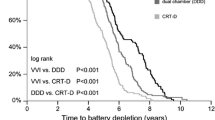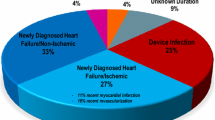Summary
The aim of the present study was to elucidate whether the duration of a technical follow-up (FU) of a pacemaker (PM)/implantable cardioverter defibrillator (ICD) has an impact on cost-effectiveness in the outpatient clinic. We determined the time required for a complete FU of devices from three different manufacturers.
In 130 patients (70 VVI/DDD-PM, 60 VVI/DDD-ICD) with either a PM (Phylos, Chorum/Talent, Kappa, EnPulse) or an ICD (Belos, Alto or GEM) the time was recorded for a complete FU including determination of lead impedance, sensing and pacing threshold. The time for activation of individual menue buttons was excluded. On the basis of time required for FU, cost-units (CU) were calculated for 2000 FU/year and for a presumed device longevity (PM 7 years, ICD 5 years).
For VVI-PM, the duration of FU was almost identical for devices from different manufacturers (105±11 s to 125±8 s; p=n.s.). However, analysis of DDD-PM revealed marked differences (140±25 s vs 282±23 s, p<0.05). Time for FU of ICDs varied between 108±5 s and 207±21 s (p<0.05) in VVI-ICDs and between 129±8 ms and 225±23 s (p<0.05) in DDD-ICDs. The total savings could be 55 000 CU in VVI- and 53 333 CU in DDD-ICDs. For full automatic DDD-pacemakers (EnPulse) time for FU could be reduced to 58±3 s (p<0.05). Differences in FU times were caused by problems with telemetry, delay during booting of the programmer, interrogation at the beginning and at the end of FU and for sensing tests.
Improving not only programmers and devices but also test automaticity could significantly increase cost-efficiency in the outpatient clinic.
Zusammenfassung
Die vorliegende Studie untersucht geräteabhängige Kostensenkungspotentiale im Prozess der Nachsorge beim Einsatz verschiedener Schrittmacher (SM) und implantierbarer Kardioverter-Defibrillatoren (ICD).
Bei 130 Patienten (n=60 VVI-SM/ICD, n=70 DDD-SM/ICD) mit implantiertem SM (Phylos, Chorum/Talent, Kappa, EnPulse) oder ICD (Belos, Alto oder GEM) erfolgte eine Zeiterfassung für die Nachsorge der Aggregate (inklusive Erst- und Endabfrage, Testung der Impedanz, Wahrnehmung intrinsischer Signale und Stimulationsreizschwelle). Das Aufsuchen der einzelnen Funktionen am Programmiergerät wurde in den Analysen nicht berücksichtigt. Um eine wirtschaftliche Evaluierung der Ergebnisse zu ermöglichen, wurden die Nachsorgezeiten mit einem fiktiven Referenzkostensatz von 200 Kosteneinheiten pro Aktivitätsstunde bewertet.
Die ermittelte Zeit pro Nachsorgevorgang variiert herstellerabhängig bei Einkammer-SM-Aggregaten von 105±11 s (Phylos) bis 125±8 s (Kappa, p>0,05). Bei DDD-SM-Aggregaten wurde eine Nachsorgezeit von 140±25 s (Phylos) bis 282±23 s (Talent, p<0,05) ermittelt. Bei ICD-Aggregaten wurden bei Einkammer-Geräten zwischen 108±5 s (Belos) und 207±21 s (Alto, p<0,05), bei Zweikammer-Aggregaten zwischen 129±8 s (Belos) und 225±23 s (Alto, p<0,05) benötigt. Die unterschiedliche Dauer der Nachsorge beruhte überwiegend auf Problemen in der Telemetrie, Verzögerungen beim Systemstart, bei Erstabfrage und Endabfrage mit Ausdruck sowie der Bestimmung der Wahrnehmung. Durch Einsatz vollautomatischer DDD-SM (EnPulse) ergibt sich eine minimale Nachsorgezeit von 58±3 s. Verglichen mit dem Wert von 282±23 s, p<0,05 beim ungünstigsten SM bedeutet dies eine Verringerung der Nachsorgekosten um nahezu 80%.
Der unterschiedliche Einfluss der Gerätetypen verschiedener Hersteller auf die Nachsorgezeit und auf die Wirtschaftlichkeit des Nachsorgeprozesses wird bestätigt. Die Leistungsfähigkeit der Programmiergeräte und die Automatisierung der Gerätetestungen bestimmen dabei die Wirtschaftlichkeit in der Nachsorge von SM/ICD.
Similar content being viewed by others
References
Bardy GH, Lee KL, Mark DB et al (2005) Sudden Cardiac Death in Heart Failure Trial (SCD-HeFT) Investigators. Amiodarone or an implantable cardioverter-defibrillator for congestive heart failure. N Engl J Med 352:225–237
Bauer J (2003) Produktionscontrolling mit SAP-Systemen. Vieweg Verlag, Braunschweig/Wiesbaden, S 137–199
Boriani G, Biffi M, Branzi A et al (2000) Benefits in projected pacemaker longevity and in pacing related costs conferred by automatic threshols tracking. Pacing Clin Electrophysiol 23:1783–1787
Chiu CC, Vicente KJ, Buffo-Sequera I et al (2004) Usability assessment of pacemaker programmers. Pacing Clin Electrophysiol 27:1388–1398
Cooper R, Kaplan RS (2000) Measure costs right, make the right decisions, harvard business review online
Crossley GH, Gayle DD, Simmons TW et al (1996) Reprogramming pacemakers enhances longevity and is cost-effective. Circulation 94:II245–47
Fraser JD, Gillis AM, Irwin ME et al (2000) Guidelines for pacemaker follow-up in Canada: a consensus statement of the Canadian Working Group on Cardiac Pacing. Can J Cardiol 16:355–363
Gillis AM, MacQuarrie DS, Wilson SL (1996) The impact of pulse generator longevity on the long-term costs of cardiac pacing. Pacing Clin Electrophysiol 19:1459–1468
Klose KJ, Böttcher J (2002) Activity Based Costing in der Radiologie, Radiologie 42:369–375
Kramer LI, Markewitz A, Frohlig G et al (2001) Curriculum “practice of cardiac pacing”. Z Kardiol 90(7):522–529
Lynd LD, O’Brien BJ (2003) Cost-effectiveness of the implantable cardioverter defibrillator. J Cardiovasc Electrophysiol 14:S99–S103
Moss AJ, Hall WJ, Cannom DS et al (1996) Improved survival with an implanted defibrillator in patients with coronary disease at high risk for ventricular arrhythmia. Multicenter Automatic Defibrillator Implantation Trial Investigators. N Engl J Med 335:1933–1940
Moss AJ, Zareba W, Hall WJ et al (2002) Multicenter automatic defibrillator implantation trial II investigators. Prophylactic implantation of a defibrillator in patients with myocardial infarction and reduced ejection fraction. N Engl J Med 346:877–883
Ridderstolpe L, Johannsen A, Skau T et al (2002) Clinical process analysis and activity based costing at a heart center. J Med Syst 26:309–322
Wiegand UKH, Potratz J, Bode F et al (2001) Cost-effectiveness of dualchamber pacemaker therapy: does single lead VDD pacing reduce treatment costs of atrioventricular block? Eur Heart J 22:174–180
Winters SL, Packer DL, Marchlinski FE et al (2001) Consensus statement on indications, guidelines for use, and recommendations for follow-up of implantable cardioverter defibrillators. North American Society of Electrophysiology and Pacing. Pacing Clin Electrophysiol 24:262–269
Author information
Authors and Affiliations
Corresponding author
Rights and permissions
About this article
Cite this article
Bauer, A., Bauer, J., Bauer, M. et al. Effizienzpotential in der Nachsorge von Schrittmachern und implantierbaren Kardioverter Defibrillatoren. Herzschr. Elektrophys. 17, 26–34 (2006). https://doi.org/10.1007/s00399-006-0504-2
Received:
Accepted:
Issue Date:
DOI: https://doi.org/10.1007/s00399-006-0504-2




